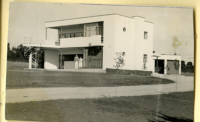A rail link that can transport travelers directly from the airport to downtown is a simple concept, yet one that has never come to fruition in North America until now. On June 6, Toronto began service of its new Union Pearson Express, a train that connects Canada’s two busiest transportation hubs, Pearson International Airport and the downtown Union Station, every 15 minutes in fewer than 25 minutes.
The new railway was, of course, in need of new stations, and the transit authorities at Toronto’s Metrolinx commissioned Canadian firm Zeidler Partnership Architects to design a terminal that would be sited conveniently adjacent to the city’s historic Beaux-Arts Union Station. The resulting 18,400-square-foot, $19-million Union Pearson Express Station has a distinctly modern, Scandinavian feel on its interior, owing to the high ceilings, beams of blonde wood, and minimalist lines.
“We’re a Nordic country, in a way,” Zeidler senior partner Tarek El-Khatib tells RECORD, referring to the two distant regions’ similarities in climate. Following a design brief that outlined a singular, Canadian brand identity (also applied to the two other, smaller UPX stations designed by MMM Architects and Adamson Associates Architects; the railway employees’ uniforms; and the interiors of the trains themselves), the team at Zeidler adhered to a palette of wood, metal, and stone, that, according to El-Khatib, “fits into the context of the North.”
The station’s northern location also dictated the firm’s incorporation of safeguards against the unforgiving, below-freezing winter climate. At each of the six train-access doors, for example, a concealed air curtain has been installed to protect passengers from a rush of cold air as they step from the platform onto the train. A small, non-irrigated green roof also contributes to the building’s insulation. The mezzanine lounge even has a facade of wood and partially fogged glass, a nod to the frost that also hides the edges of the floor and ceiling.
In addition to features that respond to the local environment, the station design also emphasizes train-appropriate themes of movement and speed. “We syncopated the roof and walls in a series of beams to imply motion,” says El-Khatib. Above the blue-grey terrazzo floors and exposed cement walls, alternating series of wood and glass bands running vertically and horizontally throughout the double-height space of the platform, sitting atop a procession of Y-shaped concrete columns. “There’s this rhythm that moves along with the train,” El-Khatib continued. The skylights also flood the space with natural light.
Given that the design draws so much from its natural surroundings, the Union Pearson Station is at once unprecedented yet very familiar.








Post a comment to this article
Report Abusive Comment